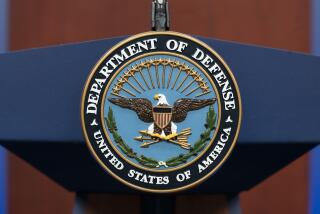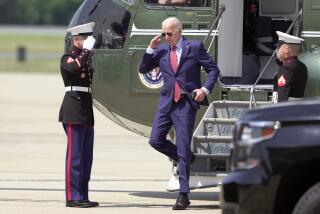Abizaid Seeks Muslim Nations’ Troops for Iraq
- Share via
WASHINGTON — Hoping to pressure allies to contribute more troops to the occupation of Iraq, the commander of U.S. forces took the unusual step Friday of publicly naming countries that he believed were in a position to send more soldiers.
Army Gen. John Abizaid, chief of the U.S. Central Command, said Pakistan was among the countries that could help the United States, which is sending more of its own troops while watching foreign forces depart.
Pakistan has said it will consider sending troops if the United Nations adopts a new Security Council resolution and after the U.S.-led occupation authority returns sovereignty to Iraqis on June 30.
“I do favor the inclusion of more international troops, especially more Muslim troops,” Abizaid told reporters via teleconference from his base in Doha, Qatar. “For example, Morocco, Pakistan, Tunisia -- they all have very capable and very professional forces that could be added to the stability equation once we move into this new level of political future that develops after negotiations in the U.N., or wherever they may take place.”
The Pentagon last month extended the deployment of U.S. troops scheduled to leave. The move added 20,000 troops to the U.S. force in Iraq, which now numbers 138,000. Despite repeated calls from Capitol Hill and elsewhere for more U.S. troops in Iraq, Abizaid said he was satisfied with their current levels. But he added that the departure of troops from Honduras, the Dominican Republic and Spain “certainly put a hole in the line at a place that we had to put troops.”
It will be a while before the U.S.-led coalition forces can rely more heavily on Iraqi troops. Abizaid said the target for completing retraining of nearly a dozen Iraqi security force units has slipped from December to as late as February.
In battles over the last month, Iraqis in the Civil Defense Corps, police and national army were unable to perform their missions, Abizaid said. Those units will be “reconstituted, retrained and, to a certain extent, reequipped,” he said.
The units often failed to fight for what their members considered to be a coalition cause, and that mentality, Abizaid said, must be changed to “reliable and loyal.”
In charge of the training effort will be Army Maj. Gen. David H. Petraeus, who led the 101st Airborne Division in the invasion of Iraq last year and the occupation of the northern region around Mosul. “I believe, and I think Iraqis will second me on this, this needs to be less of an American occupation and more of an international military activity that includes Iraqis, international forces and Americans,” he said.
As the U.S. seeks new troops, those already fighting will be receiving stepped up shipments of heavier armor, military officials said.
The intensified fighting of the last month has prompted military officials to bring in more tanks and Humvees with added armor. Marines in western Iraq have received 14 additional M-1A1 tanks in recent days, and the 1st Infantry Division has received 23 of 28 additional tanks since arriving in the country this year, Marine Gen. John Sattler said.
Commanders originally had thought that 1,000 “up-armored” Humvees would be sufficient for Iraq, but they now have 2,500 and are waiting for delivery of 2,000 more, he said. An additional 8,000 kits to shore up windows and doors on accompanying vehicles also have been ordered, he said.
Many Humvees that lack additional armor continue to be used in Iraq, but commanders and Pentagon officials insist that they are used within secure military compounds and in regions of Iraq where ambushes have not been taking place.
Sattler, the Central Command’s chief of operations, dismissed suggestions that troops went into combat with insufficient equipment. He said commanders of each military division chose what to bring in.
“No one said ‘no’ to anyone,” Sattler said. “They made the call, and we supported them, based on the enemy situation at the time. No, we did not predict that the enemy situation and the environment would change.”
More to Read
Sign up for Essential California
The most important California stories and recommendations in your inbox every morning.
You may occasionally receive promotional content from the Los Angeles Times.










